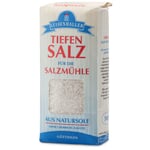Luisenhall coarse salt mill salt

Luisenhall coarse salt mill salt
- Made from natural brine from a depth of 450 meters
- Traditionally crystallized: Ladle boiling process
- For the salt mill or for seasoning savory cookies
General Information
Coarse vacuum salt. From the Saline Luisenhall
Pfannensaline Luisenhall in Göttingen, founded in 1854, the salt is brought to the surface as concentrated brine from a depth of 450 meters, where the brine has probably been trapped for millions of years away from any environmental influences. There, the brine first comes to rest in large oak basins, and suspended particles settle before being allowed to flow into boiling pans made of two-finger-thick boiler plate. Continuous coal fires burn under the large pans, heating the brine until steam rises and the salt crystallizes, which can then be skimmed off. Over the course of a year, Luisenhall produces just as much salt in this way as the big players in the industry do before their breakfast break. This coarse-grained version is suitable for the salt mill, as it is dry, or for seasoning savory cookies.
The white gold: salt
Salt, essential for our diet, has been a sought-after seasoning since ancient times. Quite a few cities founded their prosperity on the rare commodity, the "white gold", such as Halle (from Old High German hall = salt), Schwäbisch Hall or Bad Reichenhall.
Differences. Small, but fine
Today salt is available everywhere and in almost any quantity, much of it comes from industrial production and is sodium chloride in its pure form. However, cooks and connoisseurs prefer salt from vouched regions of origin, and with traditional extraction methods, a sense for the taste nuances of salts from different provenances is developing again. Because with salt it is apparently like mineral water, whose mineral content measured by volume is also very small and yet significantly affects the taste.
Scooped from the sea or mined from the mountain
The oldest form of salt extraction is the evaporation of sea water. On both the Atlantic and North Sea coasts, the sea tide is domesticated in salt marshes to this day, and the salt is moved from basin to basin under the sun until crystals form at a salt content of 280 g/l. The fleur de sel, the highest quality, is then skimmed off as a wafer-thin layer by hand with a wooden shovel.
Later, salt began to be extracted from underground veins in the form of brine. This was also the case in Luisenhall, where the brine was first extracted from great depths into saline basins. A view of the Luisenhall salt works hall shows the turquoise-green brine resting in oak basins so that suspended matter can settle before it is fed into the boiling pans. There the salt boils until the salt crystals can be harvested.
Ingredients and notes:
Sales description:
Salt
Ingredients:
Salt
Origin / provenance:
Germany
Responsible food business operator:
Saline Luisenhall GmbH Greitweg 48 37081 Göttingen Germany
Product Information
Article Number 79917
- Made from natural brine from a depth of 450 meters
- Traditionally crystallized: Ladle boiling process
- For the salt mill or for seasoning savory cookies
500 g pack
Have a question?
If you have a question concerning this product you are welcome to contact us. For this your E-Mail program will open.
Customer Service
Whether its advice, spare parts, or special requests - all your questions and concerns are handled personally and thoroughly by our customer service.
You can contact us anytime at info@manufactum.dk

